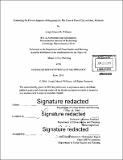Evaluating the diverse impacts of megaprojects : the case of Forest City in Johor, Malaysia
Author(s)
Williams, Joseph Marcel R
DownloadFull printable version (9.991Mb)
Other Contributors
Massachusetts Institute of Technology. Department of Urban Studies and Planning.
Advisor
Lawrence Susskind.
Terms of use
Metadata
Show full item recordAbstract
Large urban megaprojects costing billions of US dollars, erected with the promise of great economic benefits but controversial due to their environmental and social impacts, are becoming more common throughout the world. Most popular in the Middle East and in Asia, such projects exemplify how forces of globalization engage with urban form. Urban megaprojects are increasingly pursued by foreign developers looking to expand abroad but often face challenges operating in unfamiliar political and regulatory settings. Chinese developers, in particular, have global ambitions but may conflict with local priorities as they extend their reach overseas. Forest City is a vast luxury real estate development by Chinese developer Country Garden on 14 square kilometers of reclaimed land spread over four islands on the Malaysian side of the Straits of Johor, the strip of water which separates it from Singapore. This study uses Forest City as a case study to investigate the key themes associated with large urban mega projects and the impacts they have on a region. Among them is the notion that such projects are considered "exceptional" and therefore bypass traditional planning and development controls. Actors external to planning and development are suspected of co-opting the process for their own interests. Evidence collected during fieldwork from July-August 2015 and January 2016 suggests that Forest City fits neatly within these patterns and sheds light on the patterns of influence in urban development throughout the region. The case also suggests several lessons for Chinese developers operating abroad.
Description
Thesis: M.C.P., Massachusetts Institute of Technology, Department of Urban Studies and Planning, 2016. Cataloged from PDF version of thesis. Includes bibliographical references (pages 133-143).
Date issued
2016Department
Massachusetts Institute of Technology. Department of Urban Studies and PlanningPublisher
Massachusetts Institute of Technology
Keywords
Urban Studies and Planning.